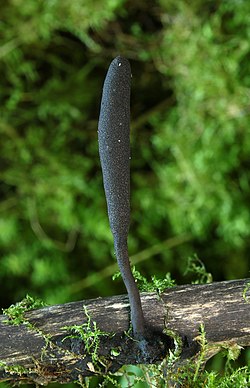| Sordariomycetes | |
|---|---|
 | |
| A single Xylaria longipes ascocarp | |
| Scientific classification | |
| Domain: | Eukaryota |
| Kingdom: | Fungi |
| Division: | Ascomycota |
| Clade: | Saccharomyceta |
| Subdivision: | Pezizomycotina |
| Clade: | Leotiomyceta |
| (unranked): | Sordariomyceta |
| Class: | Sordariomycetes O.E.Erikss. & Winka, Myconet 1 (1): 10 (1997) |
| Subclasses | |
Sordariomycetes is a class of fungi in the subdivision Pezizomycotina (Ascomycota). [1] It is the second-largest class of Ascomycota, with a worldwide distribution that mostly accommodates terrestrial based taxa, although several can also be found in aquatic habitats. [2] Some are phytopathogens that can cause leaf, stem, and root diseases in a wide variety of hosts, while other genera can cause diseases in arthropods and mammals. [3] [4]
Contents
- Subclasses and orders
- Order incertae sedis
- Familia incertae sedis
- Genera incertae sedis
- References
- Further reading
- External links
The name Sordariomycetes is derived from the Latin sordes (filth) because some species grow in animal feces, though growth habits vary widely across the class.
In 2013, it consisted of 3 subclasses, 12 orders, 600 genera and 3000 species, [5] Then by 2015, it had 3 subclasses, 28 orders, 90 families and 1344 genera. [1] This has increased to 4 subclasses and 54 orders in 2020. [6] It then increased to 6 subclasses and 54 orders in 2023. [7] In May 2023, the GBIF listed 26,295 species in Sordariomycetes. [8]
Sordariomycetes generally produce their asci in perithecial fruiting bodies.
Sordariomycetes are also known as Pyrenomycetes, from the Greek πυρἠν - 'the stone of a fruit' - because of the usually somewhat tough texture of their tissue. [9]
Sordariomycetes possess great variability in morphology, growth form, and habitat. Most have perithecial (flask-shaped) fruiting bodies, but ascomata can be less frequently cleistothecial (such as in the genera Anixiella , Apodus , Boothiella , Thielavia and Zopfiella ). [10] [11] Fruiting bodies may be solitary or gregarious, superficial, or immersed within stromata or tissues of the substrates and can be light to bright or black. Members of this group can grow in soil, dung, leaf litter, and decaying wood as decomposers, as well as being fungal parasites, and insect, human, and plant pathogens. [12] [13] [14]
Sordariomycetes are one of the classes that can also be found in the sea, such as orders, Lulworthiales and Koralionastetales, which were placed in the subclass Lulworthiomycetidae, consist of exclusively marine taxa. [15]
Some species of Sordariomycetes are economically important as bio-control agents, [16] and other genera can produce a wide range of chemically diverse metabolites, that are important in agricultural, medicinal and other biotechnological industries. [17]